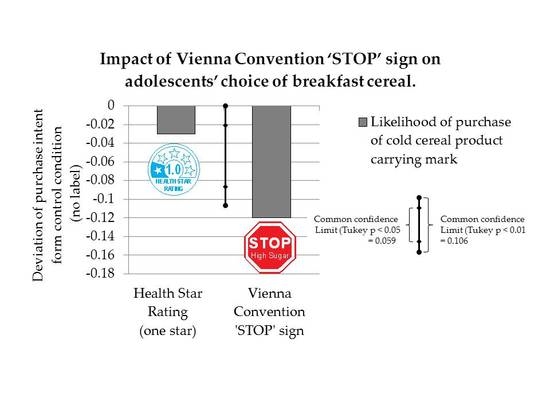An Experimental Comparison of the Impact of ‘Warning’ and ‘Health Star Rating’ FoP Labels on Adolescents’ Choice of Breakfast Cereals in New Zealand
Abstract
1. Introduction
1.1. Background
1.2. Food Consumer Education and the Use of Established International Warning Sign Formats
1.3. Research Hypotheses
2. Materials and Methods
2.1. Research Timing and Location
2.2. Experimental Design
2.3. Independent Variable
- 1)
- The VCSTOP label reproduced as specified by the Convention, but with ‘High Sugar’ added in a smaller font.
- 2)
- The AUSTRALASIAN HSR label set to a single star, the lowest level that has been observed in the cold breakfast cereal category in New Zealand, and without the optional PDI/RDI ‘add on’ bar. This label was thus set to act as an equivalent warning status to the VCSTOP label [61].
- 3)
- A ‘no FoP’ label control treatment.
2.4. Extraneous Variables
2.5. Dependent Variable
3. Results
4. Discussion
“There are two potential approaches for this option: Shape or symbol: Use of a particular shape or symbol (e.g., stop sign, give way sign, arrows, exclamation mark) accompanied with text such as ‘high in added sugars’ which would be required for foods that have an added sugars content that exceeds a certain threshold. Text box: A warning text box with a specific message…”[63]
Supplementary Materials
Author Contributions
Funding
Acknowledgments
Conflicts of Interest
References
- Hamlin, R. Marketing and regulation associated with food attributes. In Consumer Perception of Food Attributes: Consumer Perception of Food Attributes; Shigeru, M., Otsuki, T., Eds.; CRC Press: Boca Raton, FL, USA, 2018; pp. 233–251. [Google Scholar]
- Jones, A.; Neal, B.; Reeve, B.; Ni Mhurchu, C.; Thow, A.-M. Front-of-pack nutrition labelling to promote healthier diets: Current practice and opportunities to strengthen regulation worldwide. BMJ Global Health 2019, 4, 1–16. [Google Scholar] [CrossRef] [PubMed]
- World Cancer Research Fund International (WCRF). Building Momentum: Lessons on Implementing a Robust Front-of-Pack Food Label, 2019. Available online: wcrf.org/buildingmomentum (accessed on 20 May 2020).
- Kelly, B.; Jewell, J. What is the Evidence on the Policy Specifications, Development Processes and Effectiveness of Existing Front-of-Pack Food Labelling Policies in the WHO European Region? WHO Regional Office for Europe: Copenhagen, Denmark, 2018; (Health Evidence Network (HEN) synthesis report 61). [Google Scholar]
- Hamlin, R.; McNeil, S. Does the Australasian “health star rating” front of pack nutritional label system work? Nutrients 2016, 8, 327. [Google Scholar] [CrossRef]
- Hamlin, R. The consumer testing of food package graphic design. Br. Food J. 2016, 118, 379–395. [Google Scholar] [CrossRef]
- Carreño, I. Chile’s black STOP sign for foods high in fat, salt or sugar. Eur. J. Risk Regul. 2015, 6, 622–628. [Google Scholar] [CrossRef]
- Corvalán, C.; Reyes, M.; Garmendia, M.L.; Uauy, R. Structural responses to the obesity and non-communicable diseases epidemic: The Chilean Law of Food Labeling and Advertising. Obes. Rev. 2013, 14, 79–87. [Google Scholar] [CrossRef]
- Reyes, M.; Garmendia, M.L.; Olivares, S.; Aqueveque, C.; Zacarías, I.; Corvalán, C. Development of the Chilean front-of-package food warning label. BMC Public Health 2019, 19, 906. [Google Scholar] [CrossRef]
- Temple, N.J. Front-of-package food labels: A narrative review. Appetite 2019, 104485. [Google Scholar] [CrossRef]
- Grummon, A.H.; Brewer, N.T. Health Warnings and Beverage Purchase Behavior: Mediators of Impact. Ann. Behav. Med. 2020, kaaa011. [Google Scholar] [CrossRef]
- Khandpur, N.; Mais, L.A.; de Morais Sato, P.; Martins, A.P.B.; Spinillo, C.G.; Rojas, C.F.U.; Jaime, P.C. Choosing a front-of-package warning label for Brazil: A randomized, controlled comparison of three different label designs. Food Res. Int. 2019, 121, 854–861. [Google Scholar] [CrossRef] [PubMed]
- Taillie, L.S.; Hall, M.G.; Popkin, B.M.; Ng, S.W.; Murukutla, N. Experimental Studies of Front-of-Package Nutrient Warning Labels on Sugar-Sweetened Beverages and Ultra-Processed Foods: A Scoping Review. Nutrients 2020, 2, 569. [Google Scholar] [CrossRef] [PubMed]
- Aliaga-Ortega, L.; Adasme-Berríos, C.; Méndez, C.; Soto, C.; Schnettler, B. Processed food choice based on the theory of planned behavior in the context of nutritional warning labels. Br. Food J. 2019, 121, 3266–3280. [Google Scholar] [CrossRef]
- Söderlund, F.; Eyles, H.; Mhurchu, C.N. Stars versus warnings: Comparison of the Australasian Health Star Rating nutrition labelling system with Chilean Warning Labels. Aust. N. Z. J. Public Health 2020, 44, 28–33. [Google Scholar] [CrossRef] [PubMed]
- Talati, Z.; Egnell, M.; Hercberg, S.; Julia, C.; Pettigrew, S. Food Choice Under Five Front-of-Package Nutrition Label Conditions: An Experimental Study Across 12 Countries. Am. J. Public Health 2019, 109, 1770–1775. [Google Scholar] [CrossRef] [PubMed]
- Nobrega, L.; Ares, G.; Deliza, R. Are nutritional warnings more efficient than claims in shaping consumers’ healthfulness perception? Food Qual. Prefer. 2020, 79, 103749. [Google Scholar] [CrossRef]
- Khandpur, N.; Swinburn, B.; Monteiro, C.A. Nutrient-Based Warning Labels May Help in the Pursuit of Healthy Diets. Obesity 2018, 26, 670–671. [Google Scholar] [CrossRef]
- Arrúa, A.; Curutchet, M.R.; Rey, N.; Barreto, P.; Golovchenko, N.; Sellanes, A.; Velazco, G.; Winokur, M.; Giménez, A.; Ares, G. Impact of front-of-pack nutrition information and label design on children’s choice of two snack foods: Comparison of warnings and the traffic-light system. Appetite 2017, 116, 139–146. [Google Scholar] [CrossRef]
- Khandpur, N.; Sato, P.; Mais, L.; Martins, A.; Spinillo, C.; Garcia, M.; Rojas, C.; Jaime, P. Are front-of-package warning labels more effective at communicating nutrition information than traffic-light labels? A randomized controlled experiment in a Brazilian sample. Nutrients 2018, 10, 688. [Google Scholar] [CrossRef]
- Ares, G.; Aschemann-Witzel, J.; Curutchet, M.R.; Antúnez, L.; Machín, L.; Vidal, L.; Martínez, J.; Giménez, A. Nutritional warnings and product substitution or abandonment: Policy implications derived from a repeated purchase simulation. Food Qual. Prefer. 2018, 65, 40–48. [Google Scholar] [CrossRef]
- Mørk, T.; Grunert, K.G.; Fenger, M.; Juhl, H.J.; Tsalis, G. An analysis of the effects of a campaign supporting use of a health symbol on food sales and shopping behavior of consumers. BMC Public Health 2017, 17, 239. [Google Scholar] [CrossRef]
- Thomson, R.K.; McLean, R.M.; Ning, S.X.; Mainvil, L.A. Tick front-of-pack label has a positive nutritional impact on foods sold in New Zealand. Public Health Nutr. 2016, 19, 2949–2958. [Google Scholar] [CrossRef]
- Hamlin, R.P. Front of pack nutrition labelling, nutrition, quality and consumer choices. Curr. Nutr. Rep. 2015, 4, 323–329. [Google Scholar] [CrossRef]
- United States Department of Agriculture (USDA). Peru Publishes Warning Manual for Processed Product Food Labels; USDA: Lima, Peru, 2018. Available online: https://gain.fas.usda.gov/Recent%20GAIN%20Publications/Peru%20Publishes%20Warning%20Manual%20for%20Processed%20Product%20Food%20Labels_Lima_Peru_9-27-2017.pdf (accessed on 14 May 2019).
- Krizanovich, P. Peru Issues Warning Labels for Foods High in Fat, Salt, Sugar, 2018. Available online: https://www.just-food.com/news/peru-issues-warning-labels-for-foods-high-in-fat-salt-sugar_id139501.aspx (accessed on 22 May 2020).
- Israel Ministry of Health. Food Label and Nutritional Labeling; Israel Ministry of Health: Jerusalem, Israel, 2019. Available online: https://www.health.gov.il/English/Topics/FoodAndNutrition/Nutrition/Adequate_nutrition/Pages/labeling.aspx (accessed on 14 May 2019).
- Southey, L. Israel: New Opportunities for Reformulation as Gov’t. Imposes HSFF Warning Front of Pack. 27 January 2020. Available online: https://www.foodnavigator.com/Article/2020/01/27/Israel-introduces-mandatory-HFSS-warnings-front-of-pack# (accessed on 2 April 2020).
- Health Canada. Consultation on Front-of-Package Nutrition Labelling. 2017. Available online: https://www.canada.ca/en/health-canada/programs/front-of-package-nutrition-labelling.html (accessed on 14 May 2019).
- Goodman, S.; Vanderlee, L.; Acton, R.; Mahamad, S.; Hammond, D. The Impact of Front-of-Package Label Design on Consumer Understanding of Nutrient Amounts. Nutrients 2018, 10, 1624. [Google Scholar] [CrossRef]
- Troitino, C. Canada’s Proposed Front-Of-Package Nutrition Labels Take Aim At Saturated Fat, Sugar And Sodium. Forbes. 2018. Available online: https://www.forbes.com/sites/christinatroitino/2018/02/20/canadas-proposed-front-of-package-nutrition-labels-take-aim-at-saturated-fat-sugar-and-sodium/#cce543e499a1 (accessed on 22 May 2020).
- Sanjari, S.S.; Jahn, S.; Boztug, Y. Dual-process theory and consumer response to front-of-package nutrition label formats. Nutr. Rev. 2017, 75, 871–882. [Google Scholar] [CrossRef] [PubMed]
- Hamlin, R.P. Cue-based decision making. A new framework for understanding the uninvolved food consumer. Appetite 2010, 55, 89–98. [Google Scholar] [CrossRef] [PubMed]
- Scheibehenne, B.; Miesler, L.; Todd, P.M. Fast and frugal food choices: Uncovering individual decision heuristics. Appetite 2007, 49, 578–589. [Google Scholar] [CrossRef] [PubMed]
- Forbes, The World’s Most Valuable Brands. 2019. Available online: https://www.forbes.com/powerful-brands/list/#tab:rank (accessed on 22 May 2020).
- United Nations. Vienna Convention on Road Consolidated Version; United Nations: New York, NY, USA, 1968; ISBN 978-92-1-116973-7. Available online: http://www.unece.org/fileadmin/DAM/trans/conventn/Conv_road_signs_2006v_EN.pdf (accessed on 15 March 2019).
- Epstein, L.H.; Masek, B.J.; Marshall, W.R. A nutritionally based school program for control of eating in obese children. Behav. Ther. 1978, 9, 766–778. [Google Scholar] [CrossRef]
- Hamlin, R.; McNeil, L. The impact of the Australasian ‘Health Star Rating’, front-of-pack nutritional label, on consumer choice: A longitudinal study. Nutrients 2018, 10, 906. [Google Scholar] [CrossRef]
- Lawrence, M.; Dickie, S.; Woods, J. Do nutrient-based front-of-pack labelling schemes support or undermine food-based dietary guideline recommendations? Lessons from the Australian Health Star Rating System. Nutrients 2018, 10, 32. [Google Scholar] [CrossRef]
- Mhurchu, C.; Eyles, H.; Choi, Y. Effects of a voluntary front-of-pack nutrition labelling system on packaged food reformulation: The health star rating system in New Zealand. Nutrients 2017, 9, 918. [Google Scholar] [CrossRef]
- Peters, S.A.; Dunford, E.K.; Jones, A.; Ni Mhurchu, C.; Crino, M.; Taylor, F.; Woodward, M.; Neal, B. Incorporating added sugar improves the performance of the health star rating front-of-pack labelling system in Australia. Nutrients 2017, 9, 701. [Google Scholar] [CrossRef]
- Health Star Rating (HSR) Advisory Committee (HSRAC). Formal Review of the System after Five Years of Implementation (June 2014 to June 2019); Australia New Zealand Ministerial Forum on Food Regulation: Canberra, Australia, 2019. Available online: http://www.healthstarrating.gov.au/internet/healthstarrating/publishing.nsf/Content/formal-review-of-the-system-after-five-years (accessed on 22 May 2020).
- Neal, B.; Crino, M.; Dunford, E.K.; Gao, A.; Greenland, R.; Li, N.; Ngai, J.; Ni Mhurchu, C.; Pettigrew, S.; Sacks, G.; et al. Effects of different types of front-of-pack labelling information on the healthiness of food purchases—A randomised controlled trial. Nutrients 2017, 9, 1284. [Google Scholar] [CrossRef]
- Chepulis, L.; Hill, S.; Mearns, G. The nutritional quality of New Zealand breakfast cereals: An update. Public Health Nutr. 2017, 20, 3234–3237. [Google Scholar] [CrossRef] [PubMed]
- Noyes, J. Some of the worst offenders’: Sugary cereals targeted under Health Star proposal” Sydney Morning Herald, 25 June 2019. Available online: https://www.smh.com.au/business/consumer-affairs/some-of-the-worst-offenders-sugary-cereals-targeted-under-health-star-proposal-20190625-p520xz.html (accessed on 12 May 2020).
- Vandevijvere, S.; Mackay, S.; Swinburn, B. Progress by the New Zealand Government on Implementing Recommended Food Environment Policies and Prioritised Recommendations; The University of Auckland: Auckland, New Zealand, 2017. [Google Scholar]
- Fallah-Fini, S.; Vandevijvere, S.; Rezaei, T.; Heke, T.; Swinburn, B. Three Decades of New Zealand Adults Obesity Trends: An Estimation of Energy Imbalance Gaps Using System Dynamics Modeling. Obesity 2019, 27, 1141–1149. [Google Scholar] [CrossRef] [PubMed]
- Statistics New Zealand, 2018 Census; New Zealand Gvt.: Wellington, New Zealand, 2018. Available online: http://nzdotstat.stats.govt.nz/wbos/Index.aspx?DataSetCode=TABLECODE8321&_ga=2.120116303.697677236.1589359297-986474441.1589359297&_gac=1.208266790.1589359322.EAIaIQobChMI6tHL1riw6QIVxX4rCh015wwdEAAYASABEgIR1fD_BwE# (accessed on 13 May 2020).
- Atlantis, E.; Joshy, G.; Williams, M.; Simmons, D. Diabetes Among Māori and Other Ethnic Groups in New Zealand. In Diabetes Mellitus in Developing Countries and Underserved Communities; Springer: Berlin, Germany, 2018; pp. 165–190. [Google Scholar]
- Chiavaroli, V.; Gibbins, J.D.; Cutfield, W.S.; Derraik, J.G.B. Childhood obesity in New Zealand. World J. Pediatrics 2019, 15, 322–331. [Google Scholar] [CrossRef] [PubMed]
- Education Review Office (NZ). Food, Nutrition and Physical Activity in NZ Schools and Early Learning Services; ERO Wellington: Wellington, New Zealand, 2017. Available online: https://www.ero.govt.nz/publications/food-nutrition-and-physical-activity-in-nz-schools-and-early-learning-services/ (accessed on 15 March 2019).
- Education Review Office (NZ). “Food, Nutrition and Physical Activity in New Zealand Schools and Early Learning Services: Key Findings 2016”; ERO: Wellington, New Zealand, 2016. Available online: https://www.ero.govt.nz/assets/Uploads/Key-findings-report-food-nutrition-and-physical-activity.pdf (accessed on 15 March 2019).
- Dreaver, C. Slight Drop in Childhood Obesity Rates Prompts Further Research; Radio New Zealand: Wellington, New Zealand, 2019; Available online: https://www.radionz.co.nz/news/national/383949/slight-drop-in-childhood-obesity-rates-prompts-further-research (accessed on 15 March 2019).
- Louviere, J.J.; Hensher, D.A.; Swait, J.D. Stated Choice Methods: Analysis and Applications; Cambridge University Press: Cambridge, UK, 2000. [Google Scholar]
- Youden, W.J.; Hunter, J.S. Partially replicated Latin squares. Biometrics 1955, 11, 399–405. [Google Scholar] [CrossRef]
- Fisher, R.A. Statistical Methods for Research Workers; Oliver & Boyd: Edinburgh, UK, 1925. [Google Scholar]
- Fisher, R.A. The Design of Experiments; Oliver & Boyd: Edinburgh, UK, 1935. [Google Scholar]
- Banks, S. Experimentation in Marketing; McGraw-Hill: New York, NY, USA, 1965. [Google Scholar]
- Hamlin, R.P. The rise and fall of the Latin Square in marketing: A cautionary tale. Eur. J. Mark. 2005, 39, 328–350. [Google Scholar] [CrossRef]
- Wilk, M.B.; Kempthorne, O. Non-additivities in a Latin square design. J. Am. Stat. Assoc. 1957, 52, 218–236. [Google Scholar] [CrossRef]
- Australia New Zealand Food Standards Authority. Health Star Rating System Style Guide, v5; ANZFA (FSANZ): Canberra, Australia, 2017. Available online: http://healthstarrating.gov.au/internet/healthstarrating/publishing.nsf/Content/651EEFA223A6A659CA257DA500196046/$File/HSR%20Style%20Guide-v5.pdf (accessed on 15 March 2019).
- Hamlin, R.P. The Meat Purchase Decision; An Experimental Study 1997. Unpublished. Ph.D. Thesis, University of Otago, Dunedin, New Zealand.
- Food Regulation Standing Committee (Australia). Joint Food Regulation Policy Paper: Labelling of Sugars on Packaged Foods and Drinks; Department of Health: Canberra, Australia, 2019. Available online: https://foodregulation.gov.au/internet/fr/publishing.nsf/Content/C6995F10A56B5D56CA2581EE00177CA8/$File/FRSC-Policy-Paper-Labelling-of-sugars-on-packaged-foods-and-drinks-2019-06.pdf (accessed on 13 May 2020).
- Aschemann-Witzel, J.; Grunert, K.G.; Van Trijp, H.C.; Bialkova, S.; Raats, M.; Hodgkins, C.; Wąsowicz-Kiryło, G.; Koenigstorfer, J. Effects of nutrition label format and product assortment on the healthfulness of food choice. Appetite 2013, 71, 63–74. [Google Scholar] [CrossRef]
- Karnal, N.; Machiels, C.J.; Orth, U.R.; Mai, R. Healthy by design, but only when in focus: Communicating non-verbal health cues through symbolic meaning in packaging. Food Qual. Prefer. 2016, 52, 106–119. [Google Scholar] [CrossRef]
- Gibb, S.; Shackleton, N.; Audas, R.; Taylor, B.; Swinburn, B.; Zhu, T.; Taylor, R.; Derraik, J.G.B.; Cutfield, W.; Milne, B. Child obesity prevalence across communities in New Zealand: 2010–2016. Aust. N. Z. J. Public Health 2019, 43, 176–181. [Google Scholar] [CrossRef]
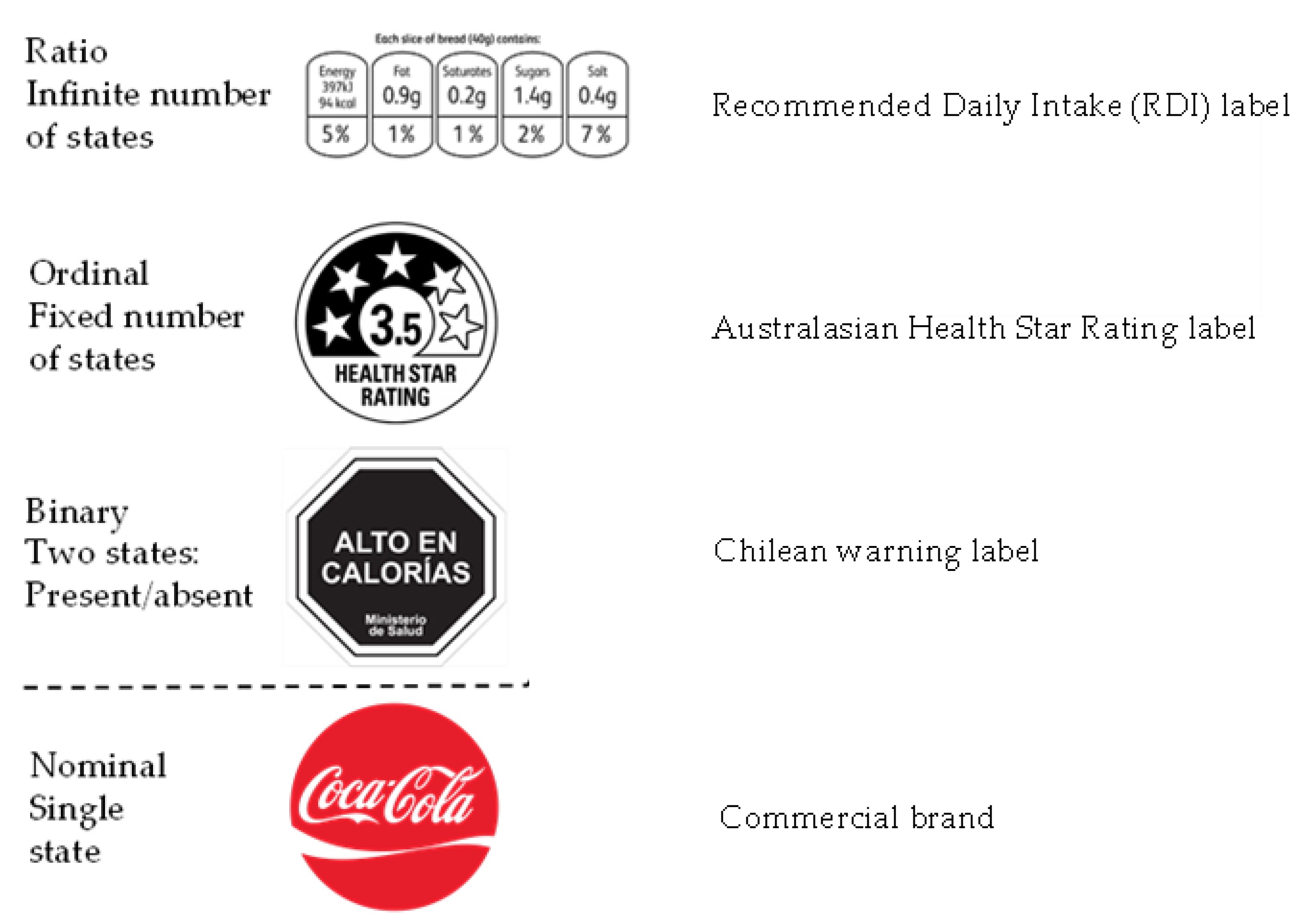
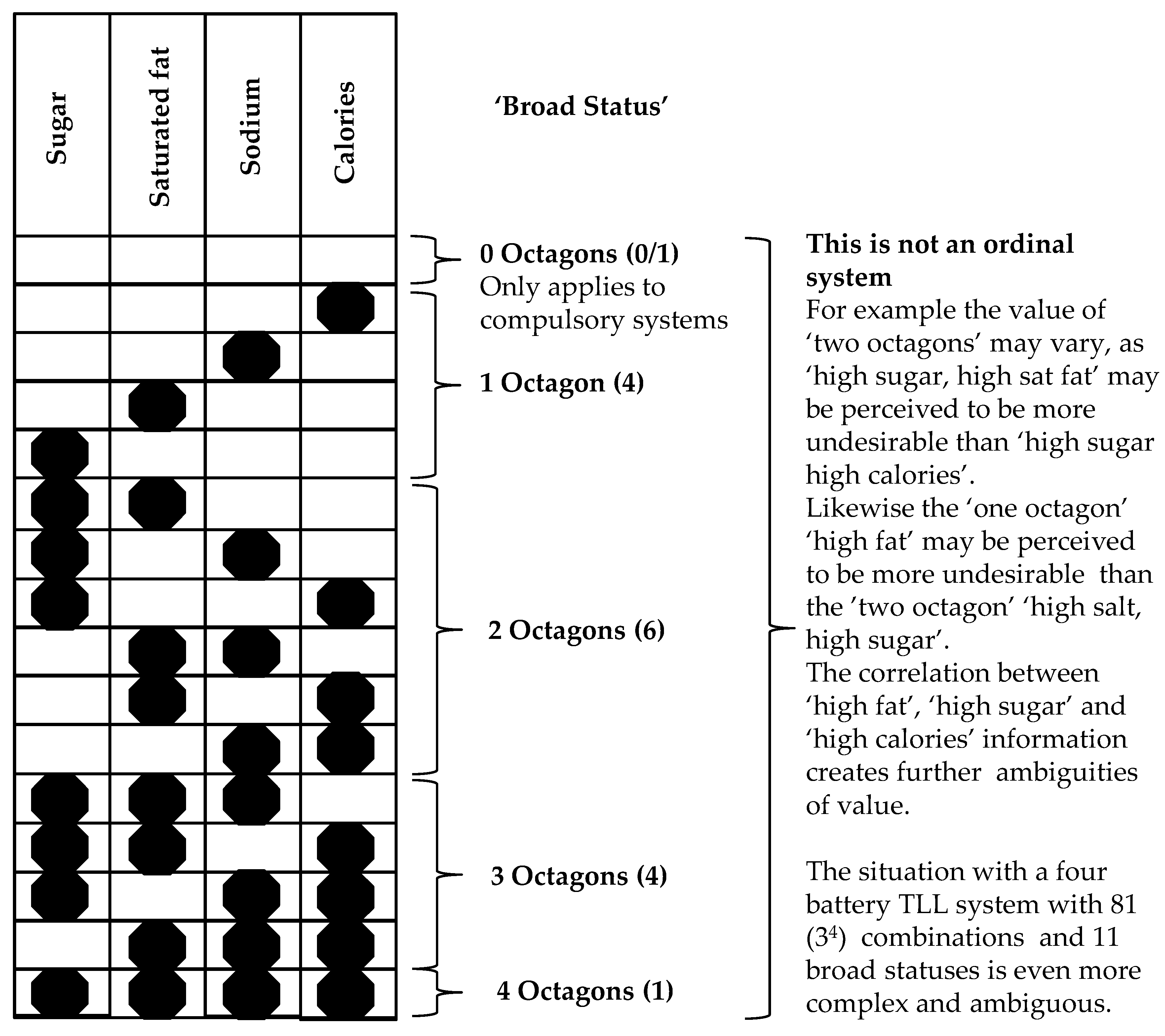
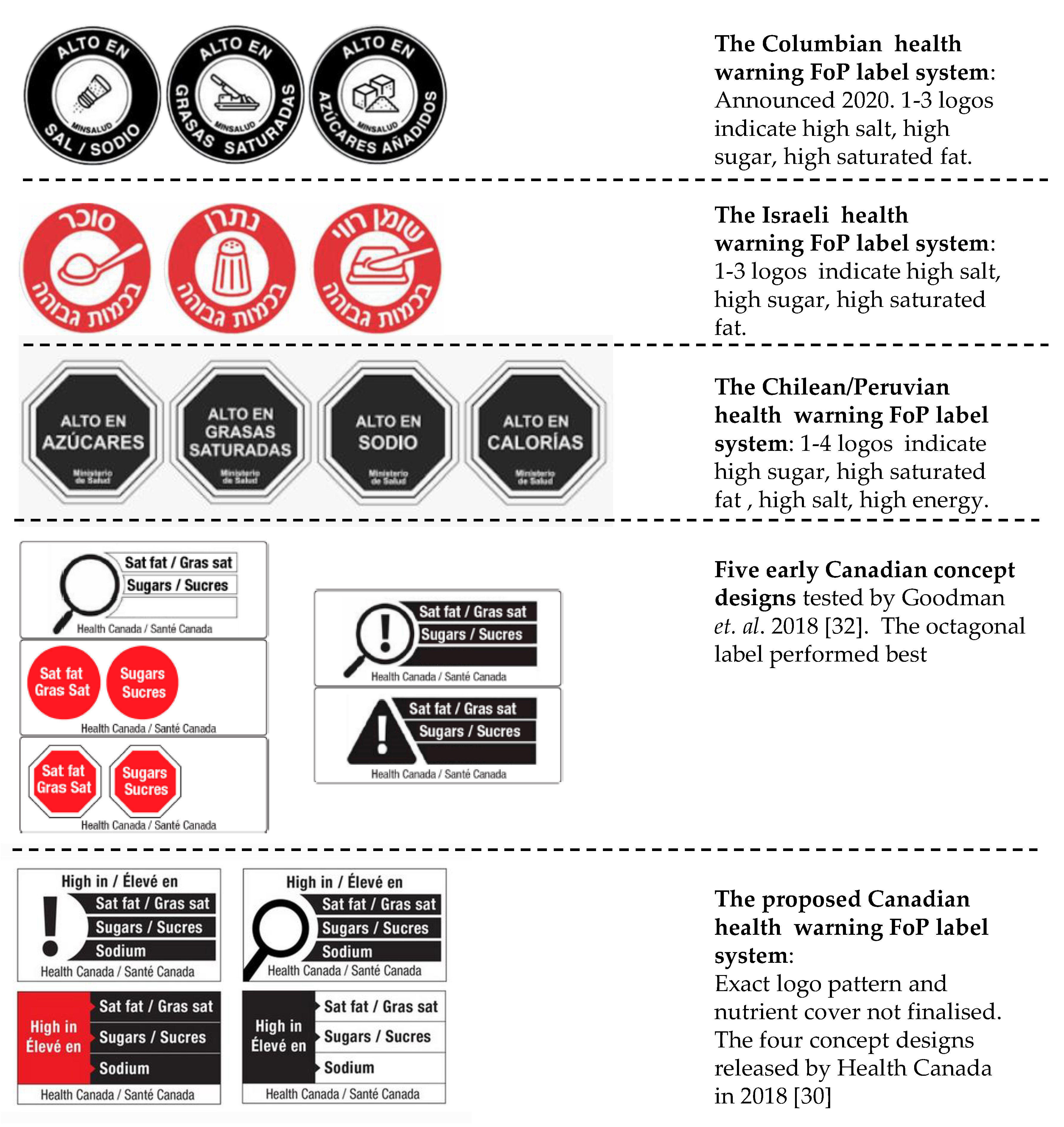
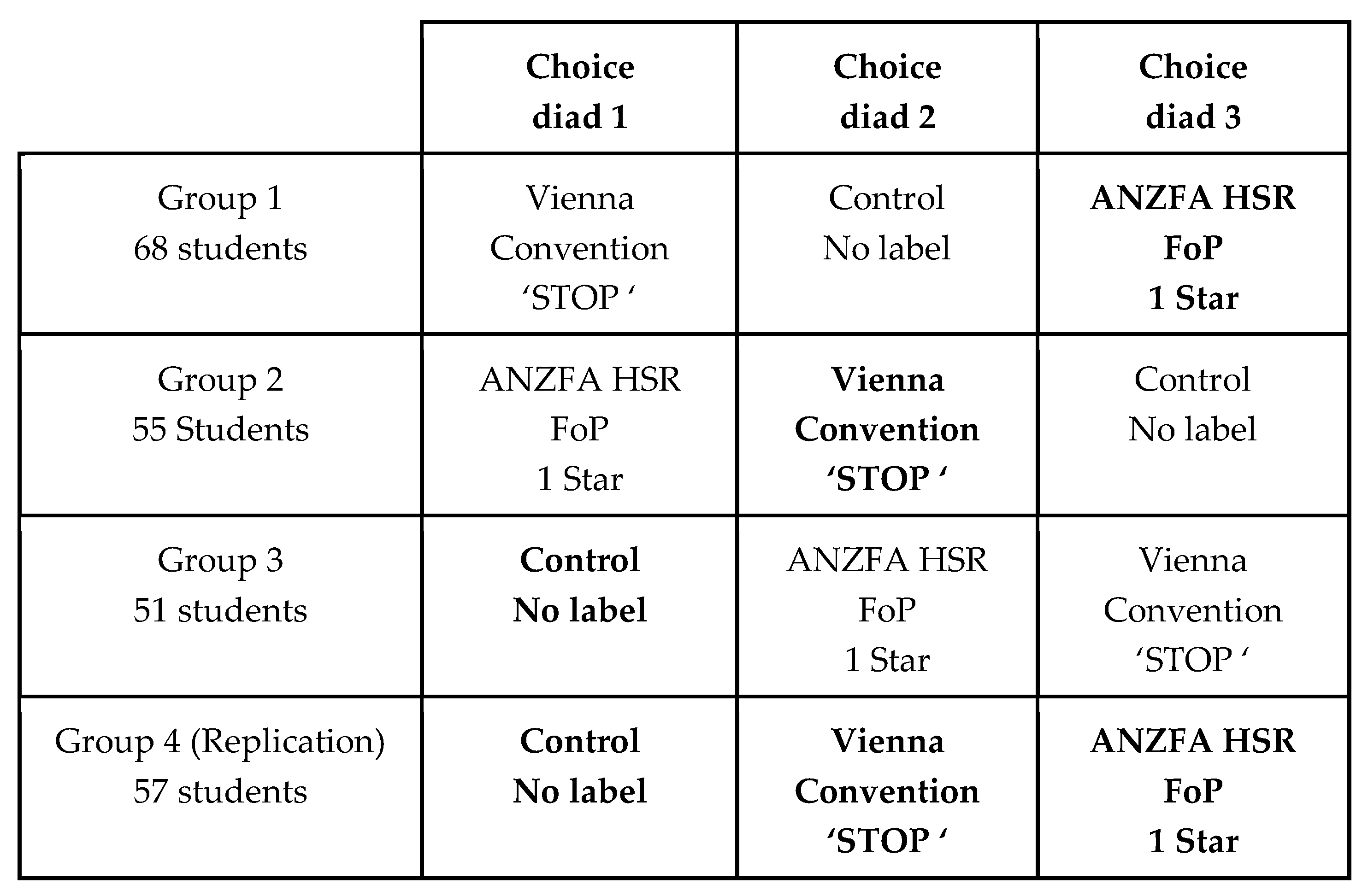

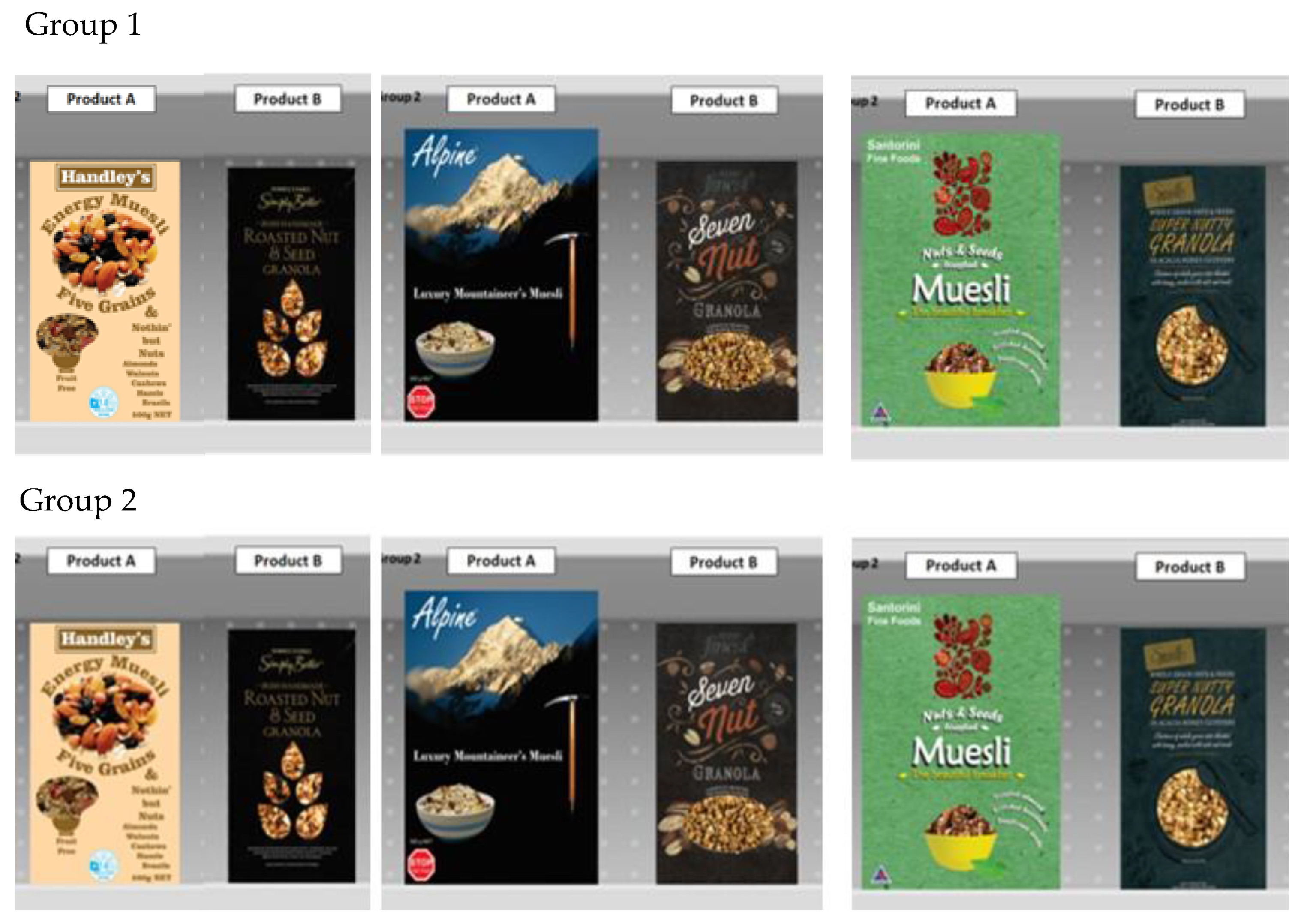
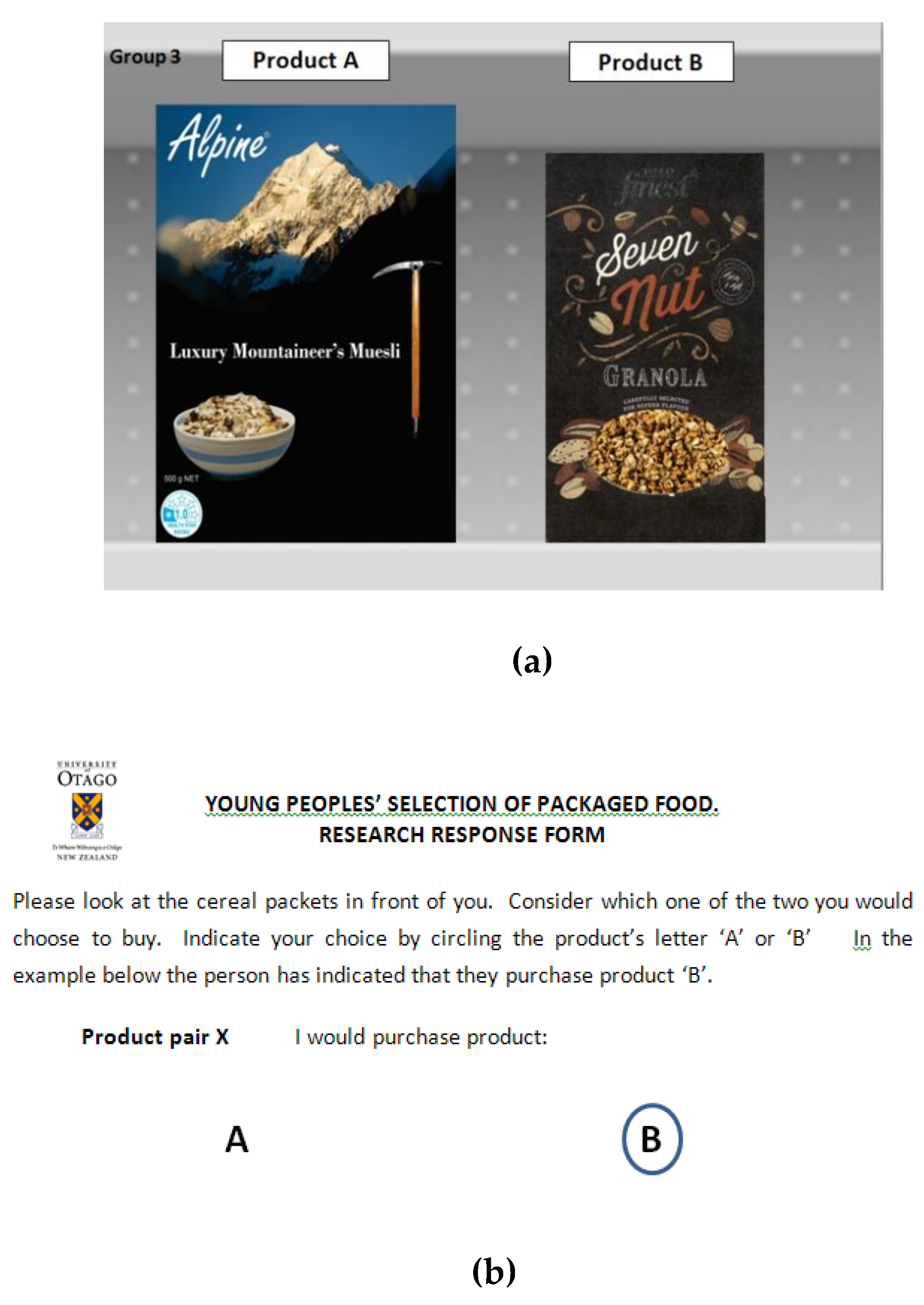
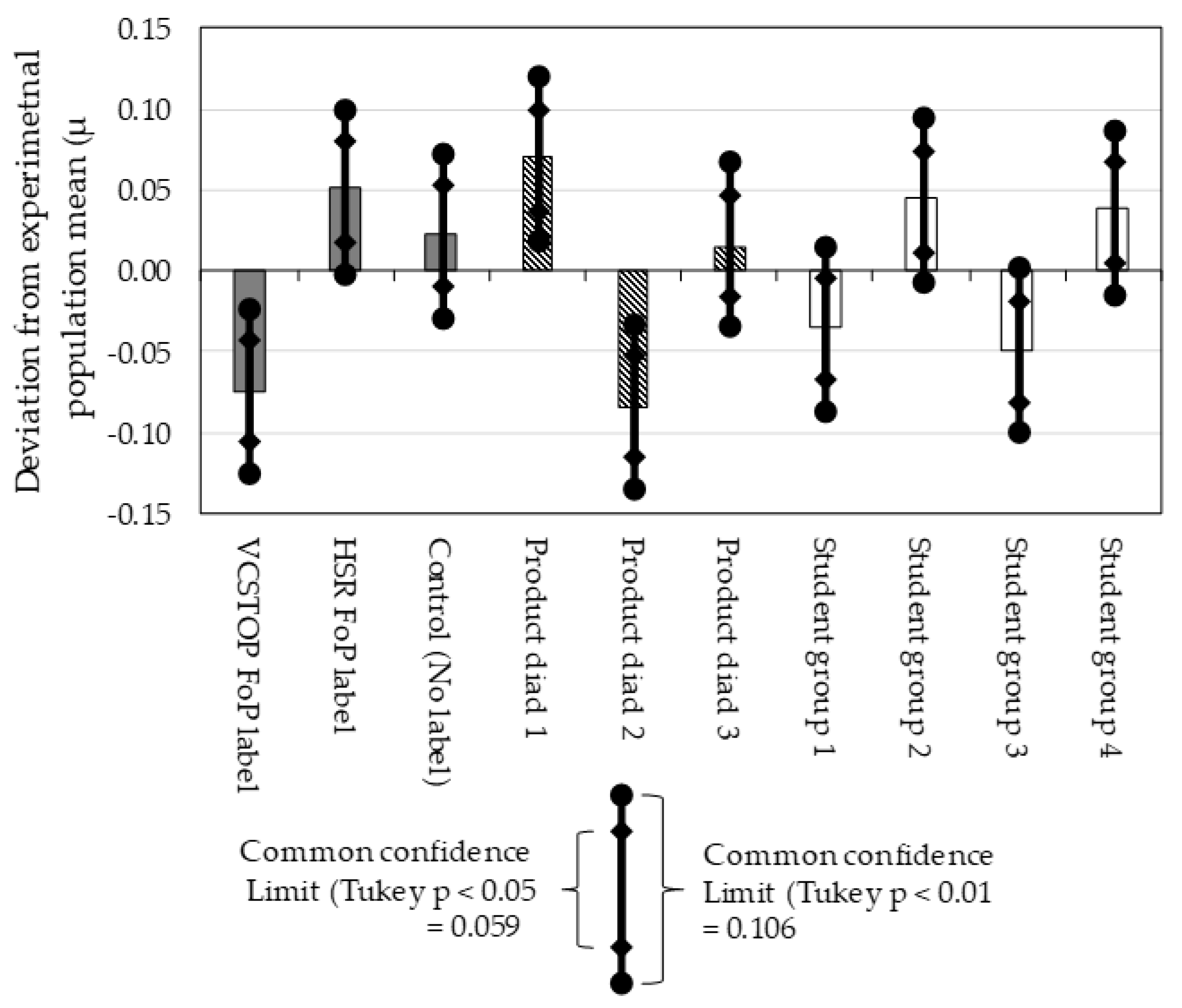
| ** | f 0.01,2,11 | 7.21 | |||
| * | f0.05,2,11 | 3.98 | |||
| NS | |||||
| Sum of Squares | Mean Squares | Df | F | Sig. | |
| Total | 0.1001 | 11 | |||
| Consumer group | 0.0027 | 0.0013 | 2 | 2.58 | NS |
| Diad | 0.0588 | 0.0294 | 2 | 57.16 | ** |
| Cue treatment | 0.0257 | 0.0128 | 2 | 24.96 | ** |
| Interaction | 0.0120 | 0.0060 | 2 | 11.64 | ** |
| Error | 0.0010 | 0.0003 | 3 | ||
| Avg. cue trt.1 | 0.43 | Cue Treatment | Cue | Cue | ||
|---|---|---|---|---|---|---|
| Avg. cue trt. 2 | 0.55 | Average diff. | trt. 1 | trt. 2 | ||
| Avg. cue trt 3 | 0.52 | Cue trt. 2 | 0.13 | |||
| Avg. Diad 1 | 0.57 | Cue trt 3 | 0.10 | 0.03 | ||
| Avg. Diad 2 | 0.41 | |||||
| Avg. Diad 4 | 0.51 | Significance | Cue | Cue | ||
| Avg. cons. grp. 1 | 0.47 | Tukey | trt. 1 | trt. 2 | ||
| Avg. cons. grp. 2 | 0.55 | Cue trt. 2 | ** | |||
| Avg. cons. grp. 3 | 0.45 | Cue trt. 3 | * | NS | ||
| Avg. cons. grp. 4 | 0.54 | |||||
| Cue vehicle | Diad | Diad | Cons. Group. | Cons. | Cons. | Cons |
| avg. diff. | 1 | 2 | Avg. diff. | group 1 | group 2 | group 3 |
| Diad 2 | 0.16 | Cons. group 2 | 0.08 | |||
| Diad 3 | 0.06 | 0.16 | Cons. group 3 | 0.02 | 0.09 | |
| Cons. Group 4 | 0.07 | 0.01 | 0.09 | |||
| Significance | Diad | Diad | Significance | Cons. | Cons. | Cons. |
| (Tukey) | 1 | 2 | (Tukey) | group 1 | group 2 | group 3 |
| Diad 2 | ** | Cons. group 2 | * | |||
| Diad 3 | NS | ** | Cons. group 3 | NS | * | |
| Cons. group 4 | * | NS | * |
© 2020 by the authors. Licensee MDPI, Basel, Switzerland. This article is an open access article distributed under the terms and conditions of the Creative Commons Attribution (CC BY) license (http://creativecommons.org/licenses/by/4.0/).
Share and Cite
Hamlin, R.; Hamlin, B. An Experimental Comparison of the Impact of ‘Warning’ and ‘Health Star Rating’ FoP Labels on Adolescents’ Choice of Breakfast Cereals in New Zealand. Nutrients 2020, 12, 1545. https://doi.org/10.3390/nu12061545
Hamlin R, Hamlin B. An Experimental Comparison of the Impact of ‘Warning’ and ‘Health Star Rating’ FoP Labels on Adolescents’ Choice of Breakfast Cereals in New Zealand. Nutrients. 2020; 12(6):1545. https://doi.org/10.3390/nu12061545
Chicago/Turabian StyleHamlin, Robert, and Benjamin Hamlin. 2020. "An Experimental Comparison of the Impact of ‘Warning’ and ‘Health Star Rating’ FoP Labels on Adolescents’ Choice of Breakfast Cereals in New Zealand" Nutrients 12, no. 6: 1545. https://doi.org/10.3390/nu12061545
APA StyleHamlin, R., & Hamlin, B. (2020). An Experimental Comparison of the Impact of ‘Warning’ and ‘Health Star Rating’ FoP Labels on Adolescents’ Choice of Breakfast Cereals in New Zealand. Nutrients, 12(6), 1545. https://doi.org/10.3390/nu12061545





